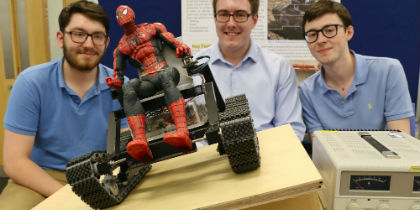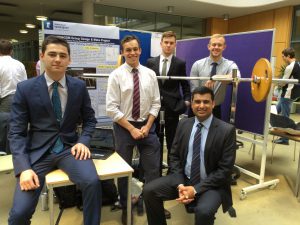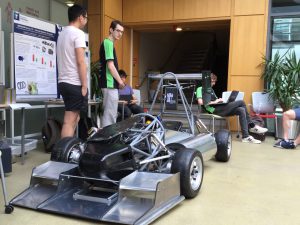
June 18, 2018, by Emma Lowry
Next generation of mechanical engineers show off their designs
An off-road wheelchair, an electric superbike, a robotic physio glove, and a portable drinks fridge that can also transport live organs are among the inventive prototypes developed by 166 third-year MEng students at the Mechanical Engineering Design Showcase. The annual end-of-year event was held 11 to 13 June at University Park with all participating teams on hand to demonstrate their problem-solving designs. Each student group selected one of 60 challenges either set by sponsoring companies or linked to ongoing research at the Faculty of Engineering.
Group Design and Make module convener, Adam Clare, Professor of Manufacturing Engineering, said: “Students learn how to behave like professional engineers and attack problems and handle adversity as you would in a real work setting. This project puts into practice all the engineering competencies learnt in years one and two, with their focus on mathematics and laboratory work, to help expand their intellectual toolbox for years to come.”
Stadium chair to evacuate injured people
St Johns Ambulance volunteers assist with first aid at events all across the country. Currently if an injured person needs evacuating from the stadium stands they rely on the Ferno chair, which is flimsy and hard to operate. The student-developed model features pneumatic wheels and a belt drive to help the chair descend stairs smoothly and safely. It is also much stronger with a bigger seat to transport larger casualties more comfortably. “We tested it with St. John’s volunteers who work at Notts County. They really liked the concept,” said team member Cameron Wilcock.
The fully electric race car was designed and built by 40 to 50 students in five groups focused on aspects such as aerodynamics and the suspension system. The lightweight car has the capacity to provide 120kW of power – around 150 bhp – which all adds to its speed capabilities. The University of Nottingham carting team is putting the car to the test at the Silverstone track for the Formula Student competition in July. “With this project I’ve learnt how to design around a lot of factors and work in a realistic work environment,” said electric race car team member, Robert Smith. “It’s not just theory. Here I’m thinking purely practically – how it will work in real life – and thats been really helpful to me. I’ve managed to get a placement with a construction company in Leicester next year. And that came from the fact I was thinking about things from a manufacturing perspective on this project.”
Goalie Gladiator
Hockey is the most popular team sport in England. Goalkeeping training usually requires a player or coach to shoot or feed balls into a modified cricket bowling machine, providing no visual cues, not helping train a keeper’s judgement. This machine, in contrast, designs a realistic training aid that used a hockey stick and miomimetic action enabling the goalkeeper to judge the type of shot and the direction, while requiring no skill to operate. The team chose to manufacture a gas spring to store the energy produced by the machine when in use.
Tennis ball impact machine
The project aim was to design and manufacture a tennis ball rebound tester for use in tennis clubs. The product criteria was compact, lightweight and able to test a tennis ball every 20 seconds. The finished prototype has with a pendulum to match drop energy. The angular rebound of the hammer is measured with a servo potentiometer, with an arduino wired to offer a green or red light to differentiate between successful or unsuccessful tests. Future developments could include adaption for testing of other sports equipment such as golf or cricket balls.
Drone
This student-designed and built Unmanned Aircraft System (UAS) is the University of Nottingham team entry into the IMechE UAS Challenge, held on 18-19 June, at Snowdonia Aerospace Centre in Wales. The UAS will be set two missions to complete autonomously – a payload delivery and a reconnaissance mission to identify two targets on the ground. The UAS has been designed with on-board controls and can fly at speeds of 60 knots in up to 25 knots wind and stay airborne for 10 minutes.

Advanced weightlifting training system
The Hyde Bar is a resistance training system that can provide the average gym-goer useful recommendations to maximise their training progress, removing the need for a personal trainer in the long term. The system could also pinpoint bad lifting techniques that could expose a user to injury or an accident. The Hyde Bar is suitable for bench presses, squats and dead-lifts. To provide the user with feedback, the bar motion is recorded using a series of sensors, strain gauges and data logging equipment mounted to the bar.
Off road wheelchair
This prototype is an off-road solution for wheelchair users that want to enjoy the countryside. It can negotiate terrain that a conventional wheelchair would find impossible. The team put an emphasis on steering, power, ground pressure and ride comfort in their design criteria. On a full-scale version the team envisages bespoke elements such as left-or right-handed controls to ensure the ultimate usability.
Hand Physio device
There are 1.2 million stroke survivors in the UK alone and it is now the largest cause of adult disability. The robotic glove is designed to help patients recover from stroke-related disabilities or hand injuries and is programmed to perform exercises designed by a physiotherapist. The glove is easy to use and is fitted using velcro straps and u-shaped finger modules. An intuitive interface calibrates the device, controls its speed and monitors a patient’s recovery progress. Instead of a physio working one on one with a patient, the gloves could treat multiple patients simultaneously. This idea could help to reduce physiotherapy waiting times and costs long-term. Currently strokes are estimated to cost £9 bn a year in the UK.
MotoStudent electric bike
The students working on this project will represent the University of Nottingham as the first British team to enter the MotoStudent International Competition, at Motorland Aragon, Spain in October 2018. The design, chosen for its simplicity and cost saving, consists of a steel tubular chassis, a box aluminium swing arm, a shock linkages rear suspension setup, a front fork and three-piece fairing.
Ankle rehabilitation device
The prototype ankle rehabilitation device aims to restore movement for patients who have sustained serious injury or mobility loss due to strokes. Past attempts to introduce mechanical aids have proved unpopular in physiotherapy with big machines that takes a lot of training to use. This device, on the other hand, can move through a full range of joint motions while withstanding the force applied by patients and keep costs to a minimum. “Our aim was to make a smaller, cheap device that could be taken up by the NHS,” said Laura Dalglish from the student design team. The device position is controlled by a joystick and is linked to a computer game that encourages the user to virtually move a ball around a maze. This design element is to encourage interaction while exercising and to distract the patient to make the rehab process more enjoyable.
Most portable fridges on the market – used for picnics, festivals and beaches – don’t offer much cooling for the electricity put in. The objective with this project was to build a portable battery-operated fridge using a vapour compression cycle. By compressing a refrigerant and running it through a circuit it offers a more efficient cooling effect. The team used 3D printing for the frame and machine parts for the condenser and the evaporator. While the design is set to an optimum temperature for beverages the settings could be adjusted to transport human organs or tissue and blood samples.
For more information about the Mechanical Engineering MEng course at the University of Nottingham, click here.
Alternatively you can contact, the admissions tutor, Dr Joel Segal.
No comments yet, fill out a comment to be the first



Leave a Reply